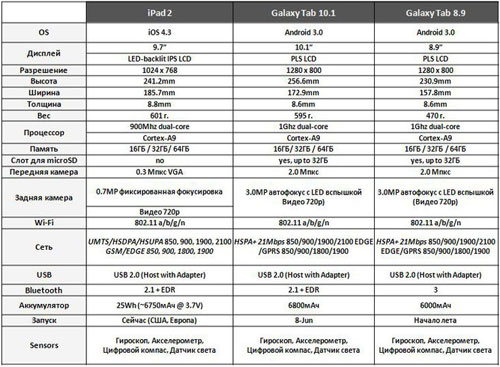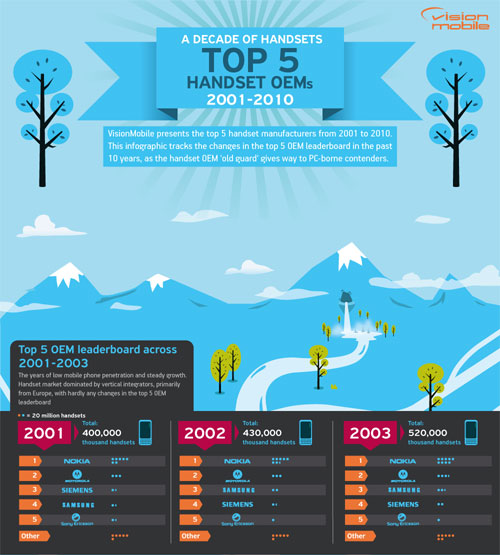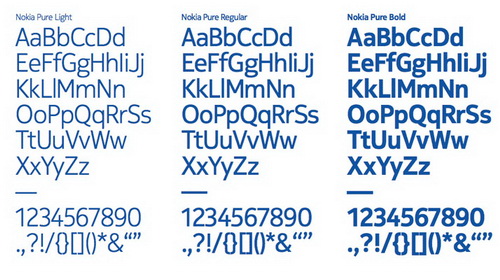Spillikins #112. Nokia changes image Ц rebranding of the company
Contents:
- Samsung Tablets Ц Response to Apple iPad2
- Google Intrigues ЦGoogle Nexus Tablet Release
- Motorola is Developing its Own OS
- Amazon is Launching an Android App Store
- Blackberry PlayBook to Receive Android Applications
- Chart: Top 5 Manufacturers 2001-2010
- Nokia Rebranding Ц New Publicity
- Nokia is Still Hanging to Symbian Ц A Story of a Lame Excuse
Last week was explosive: two bombshells that completely captured my attention. Firstly, the CTIA convention in the US where Samsung presented two new tablets and announced a sensational update for one of them. None other major manufacturer has ever done this. Secondly, Nokia is changing its image both in publicity and in the phones' UI (icons, fonts etc.). And, naturally, I am still captivated by the tablet market Ц article after an article I am trying to comprehend what is going on on this market. This issue of Spillikins is the biggest on record Ц but we have got really a lot of news. So bear with me and do not forget to tell us if you like it Ц at the bottom of the page you will find the Facebook Like button and the Twitter repost button.
Samsung Tablets Ц Response to Apple iPad2
Last week's bombshell was the announcement of two tablets by Samsung at CTIA in the US. Why a bombshell? The thing is, one of them Ц Galaxy Tab 10.1 had been already announced in February in Barcelona. But after the announcement of Apple iPad2 the company had to reconsider it and they understood that their product would lose the competition both in pricing and the specs and decided to give their tablet an overall remastering.
I must admit, I have never seen anything quite like this situation, as far as I can remember. I have mulled over all kinds of devices: some received additional functionality or a new colors or new body material, but no manufacturer has ever changed an already announced product so drastically. Samsung decided to play big and announce practically an entirely new product under the old name Ц unprecedented.
The boldness of this move is that the company has shifted the release date for a whole month from May to June. I must say that this move is logical since one should not expect that Google will be able to finish the extremely crude Android 3.0 before June. Interestingly, but HTC Flyer that was presented in February operating under Android 2.3 will be released in mid May also under Android 3.0 Ц HTC also considers Android 3.0 to be raw so far. But if you take the Google policy concerning this tablet OS into account you will understand that they could not have acted differently. I will bring up this issue a bit later Ц let us get back down to Samsung.
The Samsung tablet family now consists of three models with the screen sizes of 7", 8.9" and 10.1". They are similar to all other tablets Ц in the first half of 2011 these will be the most popular form factors. We can compare the screen sizes to regular clothes sizes:
- XS Ц 4 in; won't be announced till the second half of the year;
- S Ц 5 in - there are first examples like the ones by Dell;
- M Ц 7 in; Samsung Galaxy Tab and a number of others;
- L Ц 8.9 in Ц Samsung Galaxy Tab 8.9; HTC Flyer;
- XL Ц 10.1 in Ц Samsung Galaxy Tab 10.1 and others;
- XXL Ц from 11 in and bigger, late 2011;
So far Apple has been offering only one size Ц XL, while Android manufacturers rush to occupy all the niches of the market with different sizes. I believe this situation will remain for quite a while; Apple will be offering new sizes but will not do it as promptly as Samsung, HTC or LG. HTC has already prepared another two tablets and one of them features a 3D display. They all be released under the Flyer brand and their names will reflect the screen size and other specs (like 3D).
So, how Samsung Tab 10.1 is different from the renewed version and what makes me say that they are two different products? Firstly, Samsung made it thinner and lighter than Apple iPad2. The thickness of the body has gone down from 10.9 mm to 8.6 mm. They have also discarded the 8MPix camera and replaced it with a 3MPix one (the main camera of iPad2 has only a 0.7MPix matrix so the camera is not a critical matter). The weight remains practically unaltered Ц old 599g vs. new 595g. The body is made of plastic, at CTIA we could see older versions or prototypes that have nothing to do with the final products (both for 8.9 and 10.1). The changes were approved literally at the last moment and it is not an exaggeration. So we cannot really predict the looks of the new models: type of plastic, back panel texture etc. They might be the same or they might be different completely.
I like the weight of the tablets Ц it is easy to hold them with one hand, it is an advantage of these devices over the competitors. And the plastic is good, but I did not dare to drop them to test their dutability.
Secondly, Samsung decided to add the company's own TouchWiz4 overlay to Android 3.0. Some like it, some say that the regular Android is better. In my opinion, Honeycomb with its poor interface could use any help. However, I think that the best interface so far is Sense on HTC Flyer.
Thirdly, Samsung had the guts to reconsider the tablets pricing policy. Remember the price for the first Galaxy Tab? Not just expensive but outrageously expensive. Then during six months the price was steadily lowered until it was finally adequate. As the price went down the sales went up. A Wi-Fi version of the tablet will be released in April for about И400. The price will go down by the summer, but, unfortunately, Android 3.0 will still be not available for this tablet.
So, let us have a look at the specifications of the two new Samsung tablets as compared to Apple iPad2 and then we will get down to the pricing.
Galaxy Tab 10.1 Wi-Fi 16 GB/32 GB will be released in early June for $499/599 (И499/599 in Europe). Galaxy Tab 8.9 is expected to be released in mid June for $499 and $599 respectively for the same versions. In my opinion, the Samsung pricing policy is becoming much more adequate and the tablets have a nice price to quality ration meaning that they will be in demand. However, by the time they are released Apple iPad2 will be out for three months achieving a huge head start and will be still unbeatable. And as the rumor has it, Apple will release a differently sized iPad by fall.
From my point of view, the situation with tablet sales will remain the same and in 2011 70% of the tablet market will still belong to Apple, up to 20% to Samsung, and 10% to all the other manufacturers. This is how I see the picture.
The older Galaxy Tab 10.1 version has received an index "V" (Vodafone) and it will be sold by the carrier in a number of countries starting from late spring. I have already enumerated the differences between the versions. I have tested this tablet but since I knew about the change in specifications I decided not to write a review on it. Is there really a need for it? Are you interested in learning more about this device?



Back to the table of contents >>>
Google Intrigues ЦGoogle Nexus Tablet Release
Very often our feelings mean a lot when we are choosing a product. When we buy a car we do not buy simply a means of transportation but an expression of ourselves. We buy the way we want to look, something to match out status, something to fill a gap in our lives. The same applies to any other object including electronic products. We are driven by our feelings and even if we hear for a thousand times that something we like is defective we will still buy it if we like it. This is the power of feeling affecting out choice.
After the release Motorola Xoom review which in my opinion is not only a crude product but merely a prototype the discussion on the forum turned into a holy war. The memory card slot is not working? Not to worry, we will wait for a while, it is there and it means it will eventually work. Amazingly, it turns out that many do not even need it. And there is a zillion of argument like these. There is nothing rational in such statements. The people are driven by their feelings and they are ready to turn a blind eye to the defects of the product and buy it and then wait for a bright future. This is an example of irrationality of our choice.
The same applies to our views of the companies. Some people like Apple, and some view Google as a righteous vindicator that will save us from Apple taking over the world. It is in the human nature to impersonate companies, create simple and clear analogies. Unfortunately, in real life the companies engaged in the same domain are practically the same. It is a matter of PR and their market image. But there is not really a difference between them.
I have always found it funny people calling Google a real champ trying to make Android as open as possible and having a different approach from Apple Ц because I know what vendors talk about behind closed doors. For example, when Google Nexus failed in sales Google delayed the release of competing products of other vendors by not providing the final approval. Not forever but significantly and without any obvious reasons Ц Google was simply solving its own problems by every means available.
And we are now witnessing a similar situation on the tablet market. Google decided not to open the Honeycomb source code, not now or in the near future, because as the company stated it is not yet ready. I do not understand what "not ready" means in this context. Because, we can definitely see for ourselves that the OS is yet very crude Ц we don't need the source code for that.
The manufacturers willing to produce tablets under Android 3.0 have to sign a special licensing agreement with Google that has a number of interesting provisions. For example, a manufacturer that released a tablet for Android 2.x may not upgrade it to 3.0. Probably, this is is the reason why HTC Flyer in most versions will be released on the third version of the OS.
But what is the reason of this approach and how is it profitable for Google? I think it is obvious Ц the company is preparing its own tablet. Google ambitions go much further than mere devices. The company is shaping the future of the Internet not separate gadgets. Development of own data centers, focus on own operating systems specially designed for networking Ц these are the bricks Google is using to build the future. Tablets may become regular for households Ц as popular as TV sets but less popular than mobile phones. And every company wants a share of this market. And this is where Google encounters competition not only with Apple but also with the manufacturers that use Google OS.
Google is not any good at gadgets Ц the company simply does not have applicable experience and all the efforts of hardware production under the Google brand turned into a fiasco (remember HTC Nexus that failed mostly because of the Google team). That is why Google is cautious about this market but still Google is making bashful efforts and probes the market on a regular basis. And this time the company has decided to release a tablet. And not just to release but do it to the detriment of its partners i.e. release the latest OS on their own tablet and only then make it available for the other manufacturers. Among the major manufacturers only LG agreed to this experiment. HTC was not interested because they created an HTC Sense version for their tablets. Samsung also ignored the offer because their task is to take Apple on and beat it by any available means. Motorola is set to a different course and is being under a lot of pressure due to the Motorola Xoom returns so they do not have time to play with Android 3.0. So only LG remains among the big players. For LG even a single device released under the Google brand is a reason to blow the trumpet and rant about the quality of their products. But it will only be a one night stand and it won't change the market.
So far I do not know what will be the name of this tablet. Possibly Google Nexus Tablet, but no one knows for sure. It is scheduled to be released in mid summer or early fall and we know that the project has been running for some time. Whether it will manage to actually go out for sale is a different issue. But there is already dissent among the manufacturers and this is the time to talk about the Motorola own OS.
Additional reading:
Back to the table of contents >>>
Google Holds Honeycomb Tight
Some time ago someone started a rumor that Motorola is going drop Android and has assembled a team of engineers and coders to create an own operating system Ц and that this is an effort to create a competitor for Android that had not lived up to Motorola's expectations. There is some truth in these rumors Ц Motorola has actually assembled a team that has been working on an OS for some time now. But it is not a replacement for Android but rather an add-on.
Few know that in 2010 Motorola was looking at all the market niches searching for an expansion direction. They were searching for new products that could make the mobile subdivision profitable again. Besides tablets they also took interest in laptops and developed two models together with MSI. It did only go as far as prototypes and presentations. After having researched the market Motorola concluded that it is far too competitive. At which moment they got the idea of the dock station for ATRIX 4G and later models and it was also outsourced and developed outside Motorola.
I will remind you that the main idea of a laptop dock station is that when you insert your phone it turns into a laptop. This was merely a proof that the idea is interesting and it can work. On the laptop you see the same as on the phone with the only software difference of the full browser different from that on the phone.

It is easy to multiply 2 by 2, but those who spread the rumors about Motorola own OS failed to do so. It is not a competitor for Android but an add-on. Motorola wants to add some serious applications to the phone so when you connect it to the dock station it turns into a PC replacement. This is a future technology and Motorola is focusing on the future. Motorola is not going to drop Android, moreover, it is crucial for the success of the company. In the past the company burned their fingers trying to develop different operating systems that never became popular. Currently, the company simply does not have the resources required to create an entirely new mobile OS. But the project I have just described allows them to develop something different.
Back to the table of contents >>>
Amazon открывает собственный магазин приложений дл€ Android
Besides the fragmentation of the Android OS (there will be soon three main versions Ц for cheap phones, for expensive phones and one for tablets), Google also allowed multiple app stores for their OS. So currently there a Samsung app store that co-exists with Android Market on every Samsung phone Ц a amazing combination.
for the first time an online store is entering this market Ц Amazon decided not to lose this opportunity and secure a share so they started to sign agreements with developers. So far the store is available only in the US and offers about 4000 items. There is some free treat Ц free games but you have to register first to download them. On the first day it was Angry Birds RIO on the day I was writing this it was Dinner Dash2. The store is at: http://www.amazon.com/appstore.
There has been a bit of a scandal too Ц Apple has filed legal claims about the name of the store matching the Apple App Store. I do not think that Apple will get anything Ц this expression is far too common.
If we look at the experience of other companies like e.g. Microsoft we see that there is only one software distribution channel and it is supervised by the developer. I find this approach right Ц no extra and unnecessary entities. The more app stores there are for Android the harder it will become for a user to find his way around them and it will become a drawback of the platform. Popularity sometimes leads to detrimental consequences.

Back to the table of contents >>>
Blackberry PlayBook to Receive Android Applications
The first tablet by Blackberry will be released in April but the interesting part will start in May. RIM has officially stated that the tablet will receive support for Android applications. But it will not be quite simple Ц users will not be able to simply download and run any Android application. The developers will have to recompile their applications for Blackberry and then post it in the app store. But this will allow Blackberry to attract a lot of developers without any legal actions from Google. It is a smart move that will bring a lot of applications without a lot of efforts through leeching on a more popular OS. In terms of making business Ц it is a very clever and timely move.
Back to the table of contents >>>
Chart: Top 5 Manufacturers 2001-2010
A great chart by VisionMobile on cell phone manufacturers. View it full screen and I am sure you will find it very amusing.
Back to the table of contents >>>
Nokia Rebranding Ц New Publicity
Even before the new CEO Nokia launched a restyling of their ads and the company image. It was planned that the rebranding would be announced simultaneously with the ad campaign. But the official Nokia blog was, as usual, too hasty and released all the information long before the announcement. It was later removed and with apologies of hastiness, they also claimed that the pictures were no longer relevant. A usual Nokia. But what has been seen cannot be unseen.
First of all, Nokia is changing the fonts Ц for the first time since 1990-s. the new font style is called Nokia Pure and it was developed by Dalton Maag, its owner is Bruno Maag, a Swiss born citizen of London. These fonts will be used both in PR (ads, promos, store designs etc.) and in the devices of the company (phone and PC software fonts). Take a look at the different variations of Nokia Pure.

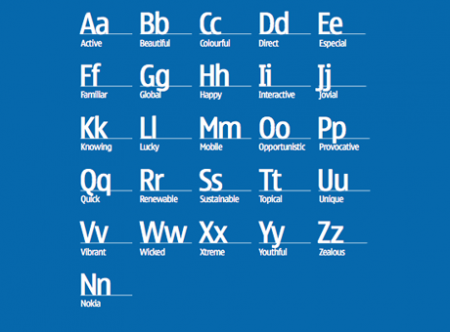

You will find more info on the development of the fonts on the Dalton Maag website.
I have had an opportunity to see these fonts live in a number of new Nokias but I cannot tell so far that they look particularly good. They are different, unusual but most importantly Ц they are new. It will take some time to get used to them. But the continuity is definitely lost so I would not say that new fonts is a good thing. Also, the fonts are not yet ready for all the languages available in a Nokia. Nokia Pure will first appear on Symbian^3 this summer.
Secondly, Nokia decided to renew the phone interface. Besides the fonts, icons will also be changed. Unfortunately, what I have seen is very close from being the final version I do not like it a single bit. See for yourself:
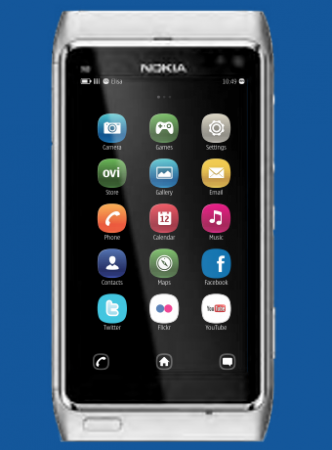
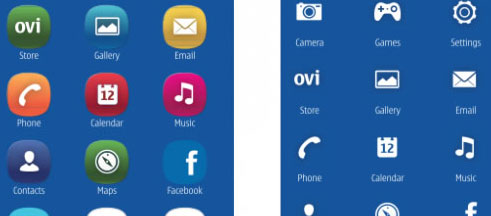
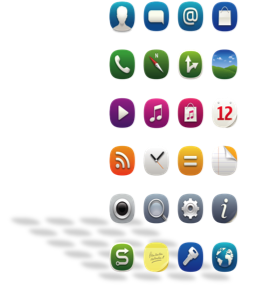
Thirdly, starting from May or summer the ad campaigns will be based on a new principle. In particular, Nokia is planning on removing all the technical specs from ads and leave only the image of the device and its name. You can see an example of this principle on the N8 ad Ц the current design is to the left Ц the new design is to the right.
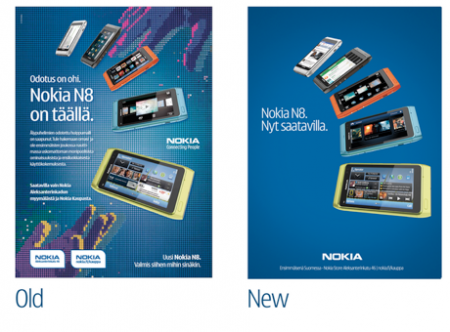
Or this Nokia E7 ad. Unfortunately I could not get a bigger image.
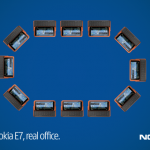
And finally, exterior ads will also be deprived of any specs and will become very depersonalized. See an example of a billboard.

Tell us whether you like this new style or not. In my opinion it is fresh blood to promo campaigns and ads that was needed for a long time and Nokia is doing it right. But the icons, UI and the fonts really grind my gears. The market players have agreed a long time ago that there should be standard fonts and that the user should be able change any system font. I hope Nokia will remember that.
Back to the table of contents >>>
Nokia is Still Hanging to Symbian Ц A Story of a Lame Excuse
I think Nokia did not know themselves what they were doing when they presented their vision of the future of Symbian. A complete termination of the system in a few years. During the pompous speeches about the future collaboration with Microsoft Nokia even showed a how it will look like Ц a memorable chart depicting a dramatic ousting of Symbian devices from the market. Have a look it:
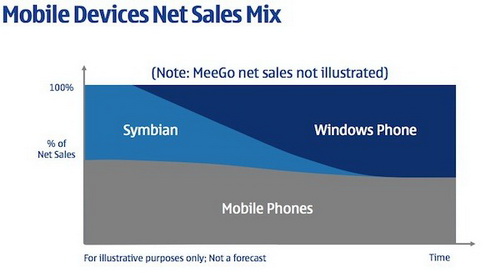
This did not allow any double interpretation. The picture speaks for itself and taking into account that the company is planning on selling 150 million Symbian smartphones more before they are fully replaced the whole transition will take about 1.5-2 years.
And you know what? The market responded very quickly. In many countries the sales of Symbian^3 smartphones plummeted. De facto, after the press has spread the word that the company's CEO had admitted that Symbian products are noncompetitive Ц consumers believed him and refrained from buying them. This was a right move only it contradicts with the Nokia's plan to sell 150 million phones with an obsolete OS. So the PR took an action and started assuring people that it is not that bad and that Symbian will not be gone in an instant. They say about a long run of Symbian. Well, clearly two years is a long time for the mobile market but all these speculations are indecorous for a respected manufacturer even if it is losing its fans that quickly. Next week Nokia is set for a serious shock Ц let us see how the company will handle it.
Do you want to talk about this? Please, go to our Forum and let your opinion to be known to the author and everybody else.
Back to the table of contents >>>
Related links
Eldar Murtazin ([email protected])
 Twitter Twitter  Livejournal Livejournal
Translated by Robert Mugattarov ([email protected])
Published — 30 March 2011
Have something to add?! Write us... [email protected]
|
